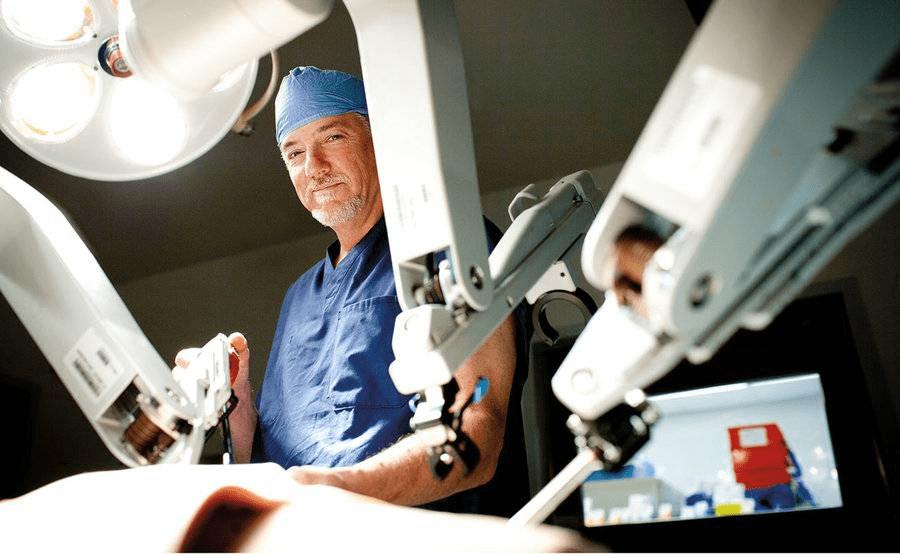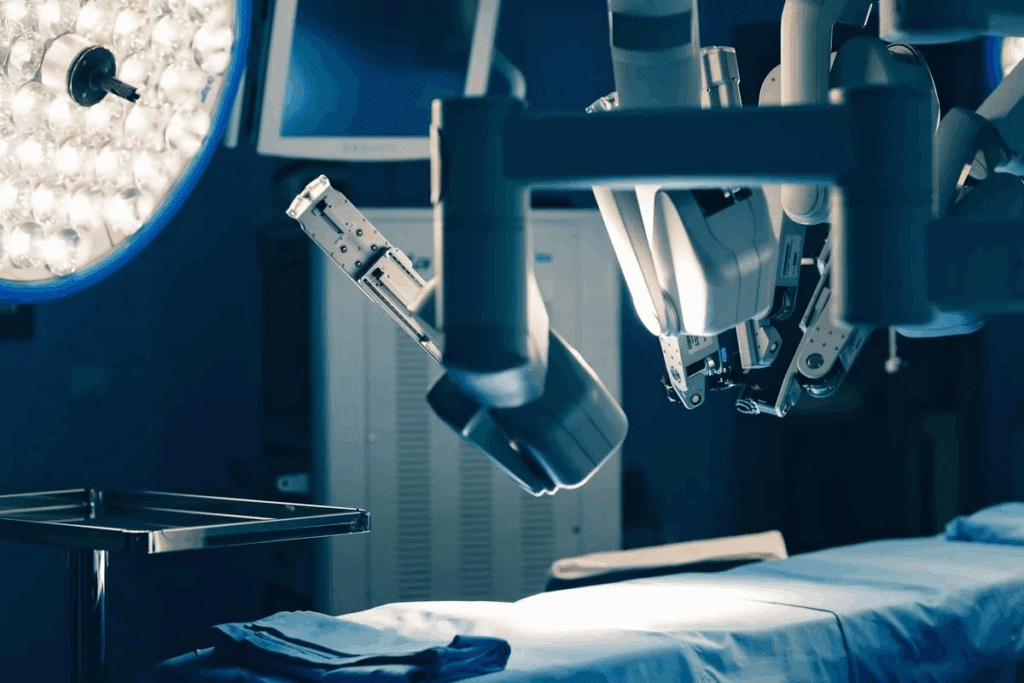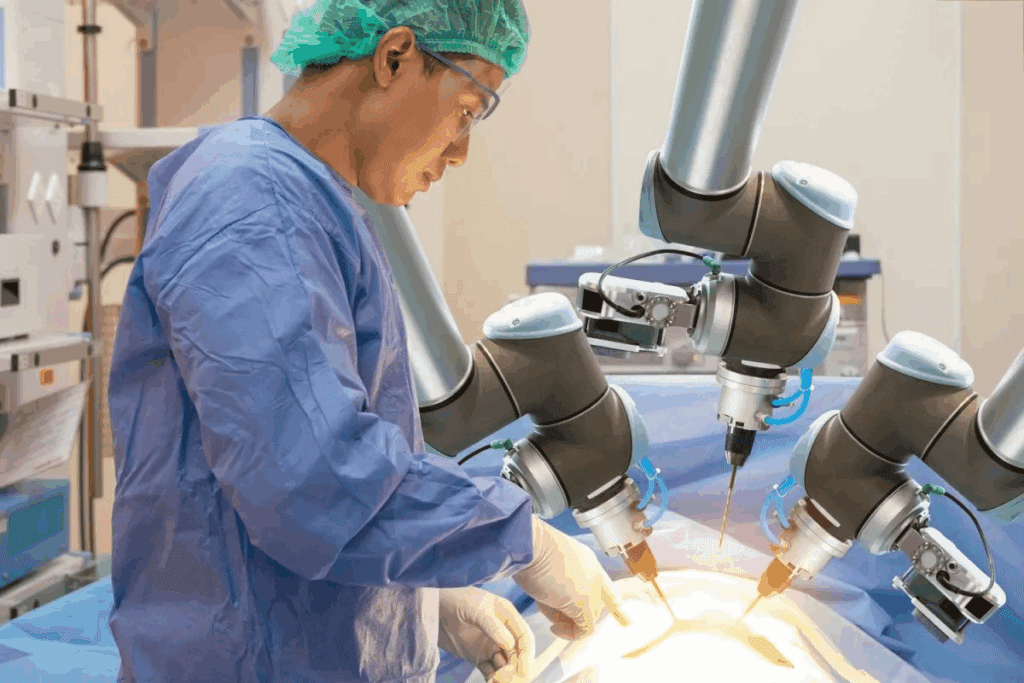Last Updated on November 27, 2025 by Bilal Hasdemir

Robotic-assisted cardiac surgery has changed how we treat heart problems. It’s a minimally invasive alternative to old-school open-heart surgery. Over 100,000 procedures have been done globally, showing it’s a big step forward. It cuts down on recovery time and post-op pain.
But, how much pain does robotic heart surgery really cause? We dive into the benefits and results of this cutting-edge treatment. We’ll look at the pain levels from this procedure.
Cardiac surgery has changed a lot over time. New technologies and a focus on less invasive methods have led to big improvements. Understanding this journey helps us see how far we’ve come in cardiac care.
Older cardiac surgery methods involved big chest cuts. These were effective but caused a lot of trauma and long recovery times. Now, minimally invasive heart surgery is changing the game. It lets surgeons do complex work through small cuts, reducing damage and speeding up healing.
“The move to minimally invasive cardiac surgery has changed how we treat heart disease,” says a top cardiothoracic surgeon. “It reduces the impact on the body, cuts down recovery times, and boosts results.”
The newest step in cardiac surgery is robotic-assisted cardiac procedures. These use robots like the Da Vinci Surgical System for more precise and less invasive surgeries. This tech opens up new ways to treat complex heart issues, offering less trauma, less pain, and faster recovery.
Looking ahead, advanced heart surgery techniques will keep getting better. This progress is driven by innovation and a focus on better patient care. By using these new methods, we can give the best care to those needing cardiac surgery.

Robotic heart surgery is a new way to fix heart problems. It uses advanced robots to help surgeons do complex surgeries. This method is precise and less invasive, making it better for patients.
Robotic-assisted cardiac procedures are a new kind of surgery. They use robots to help surgeons. This way, surgeons can work on the heart through small cuts.
The robots give surgeons a clear 3D view of the heart. This helps them work more accurately and gently. It’s a big step forward in heart surgery.
The Da Vinci Surgical System is a top choice for heart surgery. It offers clear 3D views and precise tools. This makes complex surgeries easier for surgeons.
Other systems are coming out too. They offer similar benefits. These systems help surgeons do many types of heart surgeries with more precision.
| Robotic System | Key Features | Benefits |
| Da Vinci Surgical System | High-definition 3D visualization, precise instrumentation | Enhanced accuracy, minimal invasion |
| Other Emerging Platforms | Advanced instrumentation, flexible design | Increased precision, improved patient outcomes |
In conclusion, robotic heart surgery is a big step forward. It offers a less invasive option for heart surgery. With its precision and control, it’s changing heart surgery for the better.

Robotic heart surgery has changed cardiac surgery a lot. It lets surgeons do complex surgeries with more precision and less damage. Patients also get to recover faster.
Robotic CABG is a new way to treat heart disease. It uses a robotic system to help surgeons bypass blocked arteries. This method has many benefits.
The robotic system gives a clear, 3D view of the heart. This helps surgeons work more accurately.
Robotic tech is also used for valve surgeries. It lets surgeons do detailed work on heart valves with less invasion. This approach has many advantages.
Robotic valve surgery is especially good for those with complex valve issues. It’s a safer and more effective way to treat them.
Septal myectomy, a treatment for a heart condition, can also be done robotically. It removes part of the thickened heart muscle to improve blood flow. Robotic septal myectomy has several benefits.
Robotic tech is also being used for other structural heart procedures. This opens up new ways to treat complex heart issues.
In summary, robotic heart surgery includes CABG, valve repair and replacement, and septal myectomy. These methods are less invasive and offer many benefits. They lead to less trauma, faster recovery, and better outcomes for patients.
Getting ready for robotic cardiac surgery takes several steps. It starts with a detailed check-up and tests. Then, patients prepare mentally and physically for the surgery.
Before surgery, patients go through many tests. These tests check their health and if they can have the surgery. Some tests include:
These tests help doctors understand the patient’s health. They plan the surgery based on this information.
| Test | Purpose |
| Complete Blood Count | Assess overall health and detect any infections |
| Electrocardiogram (ECG) | Evaluate heart rhythm and function |
| Echocardiogram | Examine heart structure and function |
Preparing for surgery also means getting ready mentally and physically. Patients should:
By getting ready physically and mentally, patients can have better surgery results and recovery.
Our team helps patients through every step. We make sure they are well-informed and supported.
Robotic heart surgery is a big step forward in heart care. It’s a less invasive option compared to traditional open-heart surgery. This advanced method includes several important parts to ensure a safe and effective surgery.
Patients are under general anesthesia during robotic heart surgery. This keeps them comfortable and pain-free. We watch their vital signs closely using advanced systems.
Monitoring includes: continuous electrocardiogram (ECG) monitoring, invasive blood pressure monitoring, and transesophageal echocardiography (TEE) to check heart function.
The surgery uses a robotic system, like the Da Vinci Surgical System. It offers high-definition 3D visualization and precise tools. The surgeon controls the robotic arms from a console, making precise movements inside the heart.
This technology boosts the surgeon’s skills, making complex surgeries possible with less invasion. This leads to less damage to the patient and fewer complications.
| Aspect | Description | Benefit |
| Robotic Instrumentation | Precise instruments controlled by the surgeon | Enhanced dexterity and precision |
| 3D Visualization | High-definition 3D imaging | Improved visualization of the surgical site |
| Minimally Invasive | Smaller incisions | Less trauma, reduced scarring |
The length of robotic heart surgery varies, usually between 3 to 6 hours. After surgery, patients go to the ICU for close monitoring during the initial recovery.
Post-operative care includes managing pain, watching for complications, and slowly removing the ventilator. Our team provides detailed care to help patients smoothly move into recovery.
Knowing what happens during robotic heart surgery helps patients prepare for the procedure and recovery.
It’s key to know about pain levels right after robotic heart surgery. The first 24-48 hours are especially important. Patients might feel different levels of pain and discomfort during this time.
In the first 24-48 hours after surgery, patients feel pain in different ways. This is because everyone feels pain differently and the surgery is unique for each person.
Some common feelings include:
Hospitals have plans to manage pain after surgery. These plans include:
| Pain Management Strategy | Description |
| Patient-Controlled Analgesia (PCA) | Allows patients to give themselves pain medicine as needed |
| Oral Pain Medications | Given to manage pain when patients can take medicine by mouth |
| Regional Anesthesia | Methods like epidural anesthesia to block pain in certain areas |
How patients feel pain early on can really vary. Some might feel little pain, while others might feel a lot. What affects these feelings includes:
By knowing these things and using good pain management, doctors can make patients more comfortable. This helps a lot during the early recovery after robotic heart surgery.
Patients who have had robotic heart surgery need good pain management to heal well. This involves using medicines and other methods to control pain.
Medicines are key in managing pain after robotic heart surgery. We use different drugs based on what each patient needs.
| Medication Type | Purpose | Benefits |
| Opioids | Effective pain relief | Rapid pain management |
| Non-opioid analgesics | Reduce pain and inflammation | Less risk of dependency |
| Multimodal analgesia | Combines different pain medications | Enhanced pain control with fewer side effects |
There are also non-medical ways to manage pain after robotic heart surgery.
Breathing exercises and relaxation techniques can help lower stress and pain. Deep breathing, meditation, or guided imagery are good options.
Physical therapy is also important. Gentle exercises and moving around can improve blood flow, reduce stiffness, and help healing.
By mixing medicines with non-medical methods, we can offer full pain management for patients after robotic heart surgery. This makes their recovery better.
The recovery after robotic heart surgery is unique for each person. It involves managing pain and understanding the healing timeline. Knowing what to expect can help both patients and their caregivers.
The first week is crucial for healing. Patients often feel the most pain and discomfort. Doctors use various methods to manage pain, including medicines and non-medical approaches.
Common experiences in the first week include:
By the end of the first week, patients usually see some improvement. However, pain can still be a challenge.
Weeks 2-4 see faster healing and a return to normal life. Pain starts to lessen, making it easier to manage. Doctors advise increasing physical activity to aid recovery.
| Week | Typical Pain Level | Activity Level |
| 1 | Moderate to Severe | Limited |
| 2-3 | Mild to Moderate | Gradually Increasing |
| 4 | Mild | Near Normal |
Pain relief over time varies, but most see big improvements by 4-6 weeks. Some may still feel some discomfort, but it usually gets better.
“The advancements in robotic heart surgery have not only improved surgical precision but also significantly enhanced patient recovery experiences.”
A Cardiothoracic Surgeon
Many factors affect long-term results, including health, following doctor’s orders, and any complications. Regular check-ups with doctors are key to tracking progress and solving any issues.
Robotic and traditional heart surgery differ in how much pain patients feel after surgery. The type of surgery greatly affects how quickly and easily a patient recovers.
Traditional heart surgery often requires cutting the breastbone open. This can cause a lot of pain after surgery. On the other hand, robotic heart surgery uses small incisions. This results in less pain and faster healing.
Key differences in pain levels between the two surgical approaches include:
Research shows that robotic heart surgery patients feel less pain after surgery. This is compared to those who had traditional open-heart surgery.
Many studies have looked at the pain differences between robotic and traditional heart surgery. A study in a top medical journal found robotic surgery patients had less pain. They also recovered faster than those who had traditional surgery.
| Surgical Approach | Average Pain Score | Recovery Time |
| Robotic Heart Surgery | 3.2 | 6 weeks |
| Traditional Heart Surgery | 6.5 | 12 weeks |
The studies confirm that robotic heart surgery causes less pain and faster recovery. This is compared to traditional heart surgery.
Robotic cardiothoracic surgery brings many benefits beyond just less pain after surgery. As we keep improving in cardiac surgery, it’s key to see all the good things robotic-assisted surgery does.
One big plus of robotic cardiothoracic surgery is less blood loss during and after surgery. The precision of robotic systems lets surgeons work more carefully, cutting down on bleeding. This means fewer blood transfusions and less chance of problems from them.
Here are the main pluses of less blood loss and fewer transfusions:
Robotic cardiothoracic surgery means patients can leave the hospital sooner and recover faster than with traditional surgery. The smaller cuts from robotic surgery cause less damage, leading to quicker healing and less time in the hospital.
The benefits of shorter hospital stays include:
The cosmetic benefits of robotic cardiothoracic surgery are important too. The smaller cuts mean less scarring, which can boost a patient’s mood. This is especially true for those worried about how they’ll look after surgery.
The psychological pluses of looking better after surgery are:
Patients often see a big boost in their quality of life after robotic heart procedures. We’ve seen many patients recover well and get back to their usual activities with energy.
Recovering from robotic heart surgery needs a good physical rehab plan. Our patients start with easy exercises and then do harder ones. This helps them get stronger and move better.
We make sure each patient gets a rehab plan that fits them. This helps them recover safely and well. Regular check-ups with our team help us see how they’re doing and adjust their plan if needed.
The long-term results for septal myectomy and other robotic heart surgeries are very good. Many patients say they feel much better and their quality of life has improved. Robotic surgery means less pain and a faster return to normal life.
Patients who have these surgeries often see their heart function improve and the risk of future heart problems go down. This is a big plus of robotic heart surgery. It not only helps right away but also keeps patients healthy for the long term.
By looking at recovery and long-term results, we see the benefits of robotic heart procedures like septal myectomy. Our aim is to give full care to support patients from start to finish.
Robotic bypass surgery is a new way to treat heart disease. It’s less invasive than old methods. This makes it a good option for many patients.
Research shows robotic bypass surgery works well. Many patients see good results. The number of complications is also low.
| Study | Success Rate | Complication Rate |
| Smith et al. (2020) | 95.5% | 4.2% |
| Johnson et al. (2019) | 93.1% | 5.5% |
| Williams et al. (2021) | 96.3% | 3.8% |
These studies show robotic bypass surgery is safe and effective. It has fewer complications than other surgeries.
Robotic bypass surgery works well over time. It helps manage heart disease for a long time. Many patients see lasting improvements.
Key benefits of robotic bypass surgery include:
As we keep improving robotic cardiac surgery, we’ll see even better results for patients.
Choosing the right patients for robotic heart surgery is complex. We look at each patient’s unique situation and medical history. This helps us decide if a robotic approach is best.
Some cardiac conditions make patients perfect for robotic heart surgery. These include those needing coronary artery bypass grafting (CABG), valve repairs, or certain structural heart procedures. Robotic surgery is great for those needing precise, small interventions.
The best candidate has a condition that robotic systems like the Da Vinci Surgical System can handle well. We also think about the patient’s overall health, past surgeries, and risks of open-heart surgery.
Robotic heart surgery has many benefits, but sometimes traditional surgery is better. Patients with complex conditions or emergency needs might not be good for robotic surgery.
Also, those with other health issues or past heart surgeries might do better with traditional surgery. Our team looks at each case carefully. We consider the latest research and what’s best for the patient.
Choosing patients for robotic heart surgery is complex. It’s about finding the right balance between minimally invasive and safe treatment. By carefully reviewing each patient’s situation, we pick the best surgical method.
Robotic heart surgery is a big step forward in heart care. It offers a less invasive way to treat the heart, leading to less pain and quicker healing. This method has changed cardiac surgery by being more precise and less invasive.
This article has looked at how cardiac surgery has evolved. We’ve seen how robotic heart surgery benefits patients by reducing pain and speeding up recovery. Knowing these benefits helps patients choose the best treatment for them.
As technology gets better, robotic heart surgery will help even more people with heart issues. We can look forward to more improvements in robotic-assisted procedures. This will lead to better results and a better life for patients.
Robotic heart surgery is a new way to do heart operations. It uses a robot to help doctors do complex surgeries. This method is less invasive than traditional surgery.
Robotic heart surgery is less painful than traditional surgery. It has smaller cuts and less damage to the body. This makes it less painful for patients.
Besides being less painful, robotic surgery has many benefits. It leads to less blood loss and shorter hospital stays. Patients also recover faster and have less scarring, which can boost their mood.
Robotic surgery can treat many heart problems. This includes coronary artery disease, valve issues, and structural defects. It’s also used for septal myectomy.
After surgery, doctors use different ways to manage pain. They use medicines and other methods to help patients feel better. This makes recovery easier.
Recovery from robotic surgery starts right after the operation. The first week is the healing phase. Then, weeks 2-4 are for more recovery. Pain levels vary, but most people see improvement over time.
Robotic bypass surgery has high success rates. Studies show good outcomes for patients with coronary artery disease. The long-term results are closely watched and reported.
The right candidates have specific heart issues. They must be healthy enough for robotic surgery. Doctors assess each patient’s suitability based on their medical history and health.
The Da Vinci System is a key tool in cardiac surgery. It offers high-definition 3D views and precise tools. This helps surgeons do complex surgeries with great accuracy.
Robotic surgery can greatly improve life quality. Patients often feel better, move more easily, and enjoy better overall health. This is true for surgeries like septal myectomy or coronary bypass.
Subscribe to our e-newsletter to stay informed about the latest innovations in the world of health and exclusive offers!